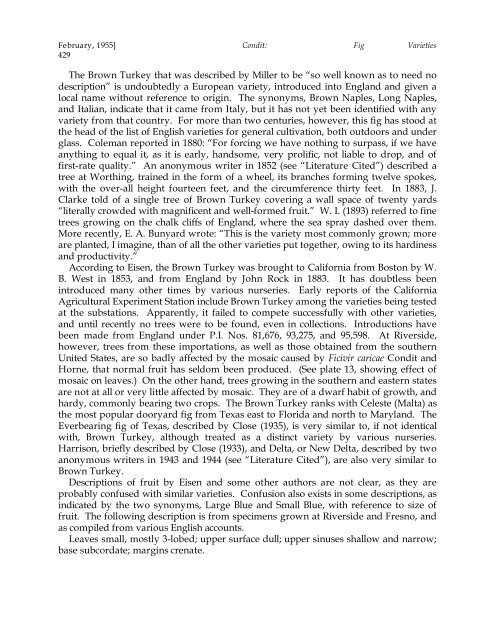Fig Varieties: A Monograph - uri=ucce.ucdavis
Fig Varieties: A Monograph - uri=ucce.ucdavis
Fig Varieties: A Monograph - uri=ucce.ucdavis
Create successful ePaper yourself
Turn your PDF publications into a flip-book with our unique Google optimized e-Paper software.
February, 1955] Condit: <strong>Fig</strong> <strong>Varieties</strong><br />
429<br />
The Brown Turkey that was described by Miller to be “so well known as to need no<br />
description” is undoubtedly a European variety, introduced into England and given a<br />
local name without reference to origin. The synonyms, Brown Naples, Long Naples,<br />
and Italian, indicate that it came from Italy, but it has not yet been identified with any<br />
variety from that country. For more than two centuries, however, this fig has stood at<br />
the head of the list of English varieties for general cultivation, both outdoors and under<br />
glass. Coleman reported in 1880: “For forcing we have nothing to surpass, if we have<br />
anything to equal it, as it is early, handsome, very prolific, not liable to drop, and of<br />
first-rate quality.” An anonymous writer in 1852 (see “Literature Cited”) described a<br />
tree at Worthing, trained in the form of a wheel, its branches forming twelve spokes,<br />
with the over-all height fourteen feet, and the circumference thirty feet. In 1883, J.<br />
Clarke told of a single tree of Brown Turkey covering a wall space of twenty yards<br />
“literally crowded with magnificent and well-formed fruit.” W. I. (1893) referred to fine<br />
trees growing on the chalk cliffs of England, where the sea spray dashed over them.<br />
More recently, E. A. Bunyard wrote: “This is the variety most commonly grown; more<br />
are planted, I imagine, than of all the other varieties put together, owing to its hardiness<br />
and productivity.”<br />
According to Eisen, the Brown Turkey was brought to California from Boston by W.<br />
B. West in 1853, and from England by John Rock in 1883. It has doubtless been<br />
introduced many other times by various nurseries. Early reports of the California<br />
Agricultural Experiment Station include Brown Turkey among the varieties being tested<br />
at the substations. Apparently, it failed to compete successfully with other varieties,<br />
and until recently no trees were to be found, even in collections. Introductions have<br />
been made from England under P.I. Nos. 81,676, 93,275, and 95,598. At Riverside,<br />
however, trees from these importations, as well as those obtained from the southern<br />
United States, are so badly affected by the mosaic caused by Ficivir caricae Condit and<br />
Horne, that normal fruit has seldom been produced. (See plate 13, showing effect of<br />
mosaic on leaves.) On the other hand, trees growing in the southern and eastern states<br />
are not at all or very little affected by mosaic. They are of a dwarf habit of growth, and<br />
hardy, commonly bearing two crops. The Brown Turkey ranks with Celeste (Malta) as<br />
the most popular dooryard fig from Texas east to Florida and north to Maryland. The<br />
Everbearing fig of Texas, described by Close (1935), is very similar to, if not identical<br />
with, Brown Turkey, although treated as a distinct variety by various nurseries.<br />
Harrison, briefly described by Close (1933), and Delta, or New Delta, described by two<br />
anonymous writers in 1943 and 1944 (see “Literature Cited”), are also very similar to<br />
Brown Turkey.<br />
Descriptions of fruit by Eisen and some other authors are not clear, as they are<br />
probably confused with similar varieties. Confusion also exists in some descriptions, as<br />
indicated by the two synonyms, Large Blue and Small Blue, with reference to size of<br />
fruit. The following description is from specimens grown at Riverside and Fresno, and<br />
as compiled from various English accounts.<br />
Leaves small, mostly 3-lobed; upper surface dull; upper sinuses shallow and narrow;<br />
base subcordate; margins crenate.















![Fig Trees in North Carolina [Archive] - IDigMyGarden ... - Figs 4 Fun](https://img.yumpu.com/26905320/1/190x245/fig-trees-in-north-carolina-archive-idigmygarden-figs-4-fun.jpg?quality=85)
